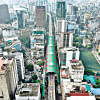Dhaka in motion: Views from a Metro Ride

Have you ever felt a sense of stillness when riding the metro in Dhaka? No, not the kind that implies silence or rest -- Dhaka doesn't allow for that -- but a quieter hum, like the city holding its breath? I am sure you did, if you somehow managed to take a ride during a less crowded hour, since it's hard for anyone to even breathe inside during the rush hour!
From the elevated tracks, you will see Dhaka's contrasts coming alive. This chaotic city goes silent inside the metro couches. The noise of the streets fades behind the glass, and all that remains is a quiet theatre of sights -- a sprawling megacity revealing itself in fragments, each more vivid and contradictory than the last.
From Motijheel to Uttara North, the first thing you might notice is the majestic Baitul Mukarram National Mosque, standing there as a timeless sentinel of a bygone age on one side. On the other, you may see the glinting high-rises heralding the city's aspirations for the future.

The juxtaposition is striking — a reminder that Dhaka's soul resides in its ability to embrace the old and the new with equal fervour.
As the train glides past Sochibaloy (Secretariat), your gaze is irresistibly drawn to the Chummery House and then the bold red Curzon Hall, commanding attention with its unique charm and profound historical significance.
Further along, the lush canopy of trees in Suhrawardy Udyan offers a soothing contrast to the urban hustle, while the solemn Mausoleum of Three Leaders stands quietly among the greenery, reminding of the sacrifices that shaped the nation. Swadhinata Stambha (Independence Monument) says hi to you in between, another poignant reminder of our independence. The Mukta Mancha seems actually mukta (free) from above here. The journey will start feeling like a theatre show at this point.
But the clatter of steel wheels against tracks and the sudden screech as it slows into the station, along with the occasional announcements, might pull you out of your thoughts. And when another metro rushes past on the opposite track — a sudden blur of motion — it can make your heart skip a beat. So be aware!

As the metro snakes through Shahbagh and beyond, you will see the new, well-furnished corporate or commercial high-rises adjusting with the old ones. The city seems like a jungle of concrete here.
However, before you reach Bijoy Sarani, the Parliament House's stunning greenery — neatly kept parks and manicured lawns — will surely calm your eyes, offering a brief reprieve from the urban sprawl.
The landscape views shift from here to Uttara North, much like the traditional bioscope imagery. You will see a series of buildings, new and old, then a series of plains; especially after crossing the Pallabi station, the tight embrace of concrete loosens here, and you might feel like crossing the middle of nowhere.

As you can see, the Dhaka metro doesn't merely traverse geography; it encapsulates time. The stations, with their clean lines and utilitarian designs, speak of an attempt to order a city that resists neat narratives. Outside, the city is a storyteller -- its rooftops hung with laundry, its streets alive with people and traffic, its walls splashed with murals, graffiti, and posters proclaiming political manifestos. Even the passing skies play their part. In this elevated world, Dhaka seems gentler.
The Metro here is more than its architecture of steel and concrete. It is a mirror, reflecting a city that is never still, never silent, always in motion.

 For all latest news, follow The Daily Star's Google News channel.
For all latest news, follow The Daily Star's Google News channel. 








Comments